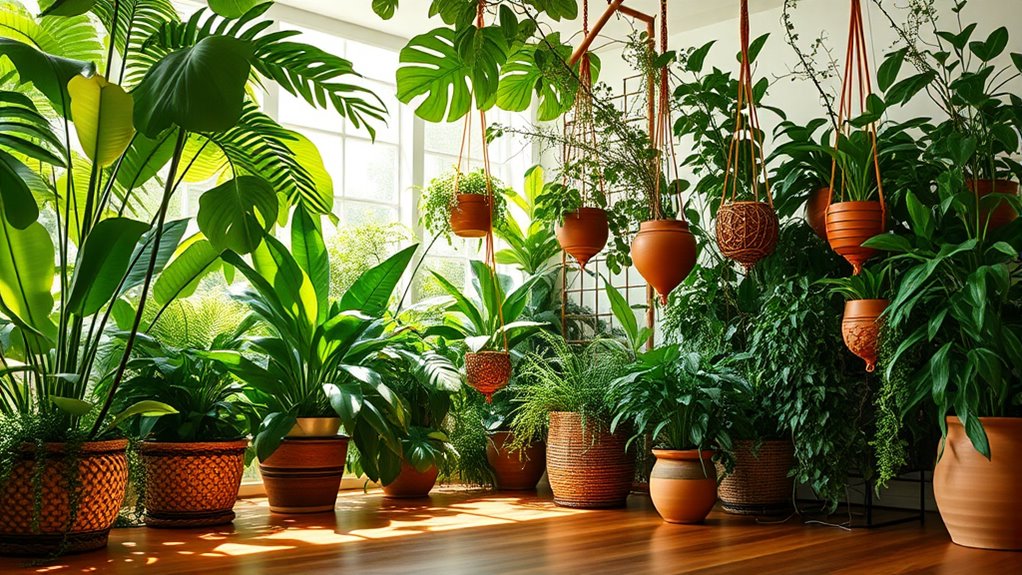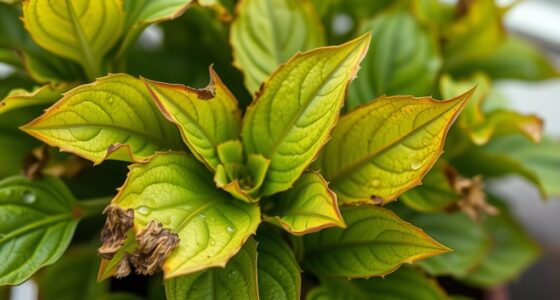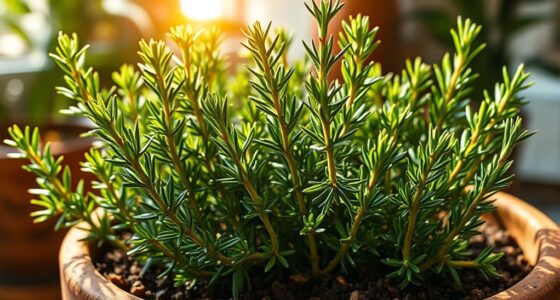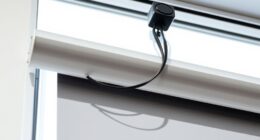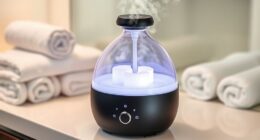To keep your houseplant forest thriving, focus on understanding each plant’s specific needs for light, water, and humidity. Use grow lights or natural sunlight, mist plants, and make certain good airflow for a healthy environment. Regular pruning and choosing stylish pots can enhance the space’s look, while decorative accents add personality. Staying consistent with care routines will transform your home into a lush indoor jungle—discover more tips to create your vibrant green paradise.
Key Takeaways
- Research each plant’s light, water, and humidity needs to create a thriving, diverse indoor jungle.
- Use grow lights and natural light adjustments to ensure all plants receive adequate illumination.
- Maintain proper airflow and humidity levels, misting dry air and preventing mold or pests.
- Regularly prune and remove dead leaves to promote healthy growth and prevent overcrowding.
- Decorate with stylish pots, hanging planters, and natural accents to enhance the jungle’s aesthetic appeal.
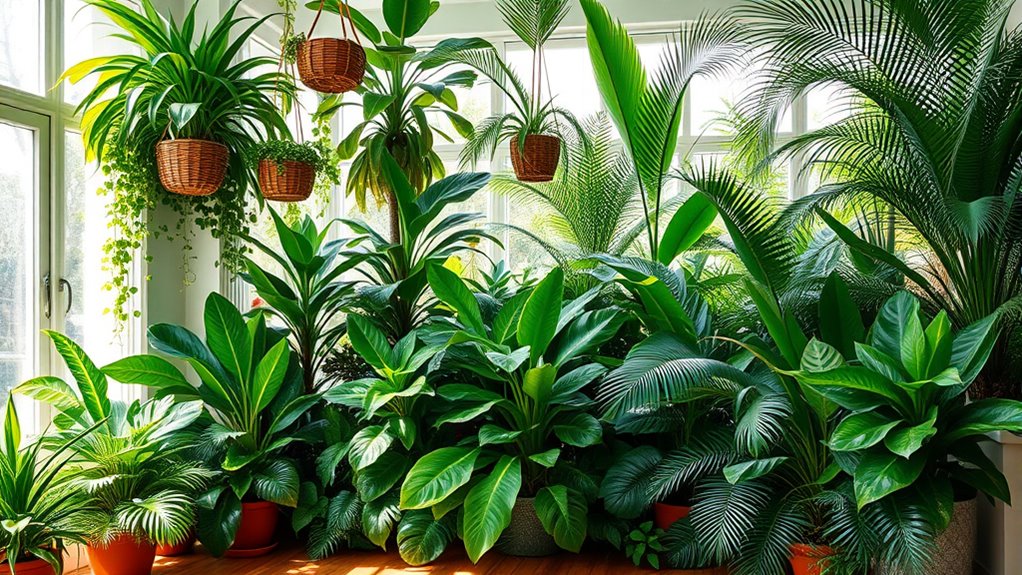
Have you ever wondered how to transform your limited indoor space into a lush, vibrant oasis? Creating an indoor jungle isn’t just about filling your home with plants; it’s about carefully cultivating a thriving green environment that feels alive and inviting. The foundation of this transformation lies in understanding plant care. Each plant has unique needs—some thrive in direct sunlight, while others prefer low light. You’ll want to research the specific requirements for your chosen plants to guarantee they stay healthy and vibrant. Proper watering is essential; overwatering can lead to root rot, while underwatering causes stress and leaf drop. Use the finger test to check soil moisture and establish a regular watering schedule tailored to each plant’s needs.
Lighting is another fundamental aspect of plant care. If your space doesn’t get enough natural light, consider supplementing with grow lights designed for indoor plants. These lights mimic sunlight and help your plants photosynthesize efficiently, promoting lush growth. Consistent humidity and airflow also play roles in keeping your jungle thriving. Mist your plants if the air is dry, and ensure good circulation to prevent mold or pests. Regular pruning not only keeps your plants looking neat but also encourages new growth and prevents overcrowding, which is essential in a dense indoor forest.
Decorative accents serve as the finishing touches that elevate your indoor jungle from a simple collection of plants to a cohesive, stylish space. Use decorative pots and planters that complement your interior decor—think textured ceramics, colorful glazed containers, or minimalist concrete styles. Hanging planters and wall-mounted plant holders can maximize space and add visual interest, making your jungle feel more dynamic. Incorporate natural elements like driftwood, pebbles, or moss around the pots to create a more naturalistic vibe. You can also add decorative accessories like fairy lights, sculptures, or botanical artwork to enhance the overall aesthetic.
Frequently Asked Questions
How Do I Prevent Pests in My Indoor Plant Collection?
To prevent pests in your indoor plant collection, you should adopt effective pest prevention strategies like inspecting new plants before bringing them inside and keeping your environment clean. Use natural pest control methods such as neem oil or insecticidal soap to deter pests without chemicals. Regularly monitor your plants for early signs of trouble, maintain proper watering practices, and guarantee good airflow, all of which help keep pests at bay and your plants healthy.
What Are the Best Plants for Low-Light Indoor Environments?
Did you know that over 40% of indoor plants thrive in low-light conditions? For your space, opt for plants like snake plants, pothos, or ZZ plants—they’re hardy and require minimal sunlight. Succulent varieties with exotic foliage, like haworthia or aloe, also adapt well to dimmer spots. These choices keep your indoor jungle lush without needing bright windows, making your house a thriving green oasis even in low-light areas.
How Often Should I Rotate My Houseplants for Even Growth?
You should rotate your houseplants every few weeks to guarantee even growth. This practice helps balance light exposure, preventing plants from leaning toward the light source. By regularly turning your plants, you promote healthy, symmetrical growth and prevent uneven stretching. Keep an eye on how each plant responds, and adjust the rotation frequency as needed. Consistent plant rotation is key to maintaining a vibrant, thriving indoor garden.
What Are Common Signs of Overwatering or Underwatering?
Watch for watering woes—wilting, yellowing leaves, or soggy soil often signal overwatering, risking root rot. Conversely, dry, brittle leaves and crisp edges hint at underwatering. You can catch these clues early, avoiding damage to your plant’s health. Proper watering prevents issues, preserves essentiality, and promotes lush growth. Pay attention to soil moisture, and always adjust your watering routine to keep your indoor jungle thriving and thriving!
How Can I Improve Indoor Air Quality With My Plants?
To improve your indoor air quality, focus on air purification through your plants. Place them strategically around your space, especially in areas with poor ventilation, to maximize their benefits. Choose plants known for filtering toxins, like snake plants or pothos. Regularly clean their leaves and avoid overwatering, which can harm their health and effectiveness. Proper plant placement and maintenance guarantee your indoor jungle works efficiently to purify your air.
Conclusion
Remember, a houseplant jungle isn’t just about beauty; it’s about creating a sanctuary for your soul. As the saying goes, “A home without plants is like a body without a soul.” With a little care and patience, your indoor forest will thrive, bringing peace and energy to your everyday life. Embrace the journey, and watch your space transform into a lush, vibrant oasis you can cherish every day.
